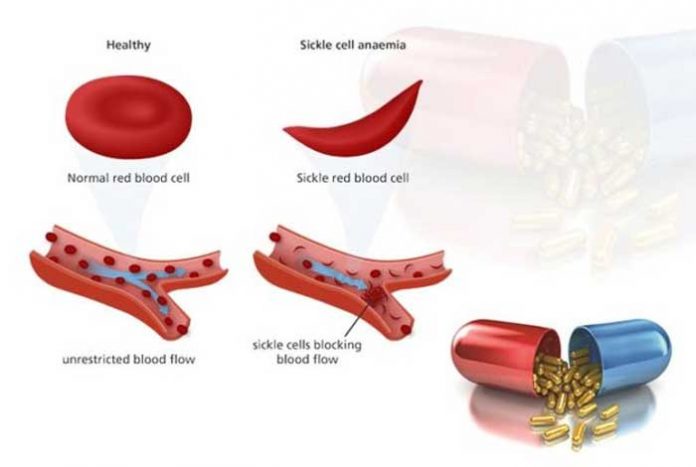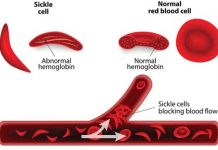
Sickle cell anemia, also known as Sickle cell disease (SCD) is a hereditary disorder, affecting the red blood cells (RBCs). RBCs contain hemoglobin, which is an iron-loaded pigment of blood that carries oxygen to various cells, tissues and organs.
Normally RBCs are disc-shaped and flexible, thus easily passing through blood vessels, ensuring adequate blood supply to all the organs of the body. Red blood cells undergo constant breakdown and production. Healthy RBCs have a life-span of 120 days, i.e., they rupture every 120 days.
In sickle cell anemia, inheritance of hemoglobin S gene from both the parent, makes the RBCs attain a sickle or crescent shape. Sickle-shaped RBCs are stiff and inflexible. Therefore, these deformed RBCs do not pass easily through blood vessels and hence, the blood supply of organs are compromised. Reduced blood supply to organs can lead to complications like stroke , gallstones, blindness, and even organ damage.
Also, these abnormal RBCs have a very short life-span of just 10-20 days, thus rupturing very frequently. While these RBCs rupture, the body is not able to compensate for the blood loss, thus creating a constant state of RBC deprivation, medically known as anemia.
Sickle cell anemia is more common in blacks and in areas with endemic malaria. It is marked by painful episodes, known as “sickle cell crisis”.
Although it is a fatal condition, the quality of life can be improved with the help of medical interventions, including medications and blood transfusion.
Symptoms
A reduction in number of RBCs and an inability of blood to reach organs adequately, lead to various symptoms. These symptoms are described below.
- Fatigue and weakness due to anemia
- Sudden painful episode, involving any part of body, more common in arms, legs, chest, belly, etc.
- Swelling of feet and hands
- Recurrent infection, like pneumonia and meningitis
- Delayed puberty
- Retarded growth
- Visual disturbances, which can even lead to blindness
However, a notable fact is that SCD is not similar to sickle cell trait. Sickle cell trait occurs when a person inherits a single defective gene, from either parent. Such individuals are healthy and have no symptoms.
Treatment
Sickle cell disease has only one cure, i.e., bone marrow transplant, which is also known as stem cell transplant. This process involves infusing stem cells from a related healthy donor to the affected individual. Stem cells have a unique ability to transform into any type of body cell. Infusing these cells produce newer healthy RBCs, thus offering complete remission from SCD. However, this procedure has several fatal complications, including death. Therefore, this is usually not indicated.
Hence, the aim of treatment of SCD is to reduce the frequency of sickle cell crisis and to prolong the life of affected people by preventing the complications of SCD. Medications and blood transfusion form the mainstay of treatment of SCD.
Chief medicines for sickle cell anemia include non-steroidal and opioid pain-killers to treat painful episodes and hydroxyurea to stimulate production of normal hemoglobin.
Nutritional supplements, including folate and glutamate may also be given to treat anemia. As per a research paper, first sign of SCD is reduced functioning of spleen, which plays a vital role in fighting against infection. Therefore, it is recommended that children below 5 years of age should be vaccinated for infections, like pneumococci, flu, etc. [1]
Severe anemia in SCD patients may require blood transfusion. Blood transfusion involves transfusing healthy blood in the body of affected individual. This reduces the amount of sickled red blood cells, thus preventing some fatal complications.
Chief drugs used in the treatment of sickle cell disease are as follows.
1. Non- Steroidal Anti-inflammatory Drugs (NSAIDs)
Pain and inflammation in our body is caused by a compound, known as prostaglandin. This compound is produced by an enzyme, called cyclo-oxygenase (COX) enzyme. NSAIDs block the COX enzyme, thus blocking the synthesis of prostaglandins.
By doing so, NSAIDs provide significant reduction in inflammation and pain during sickle cell crisis.
Available as: Oral preparations
I. Aspirin
US-FDA Status: Approved for sickle cell disease
Availability: Over-the-counter
Generic name: aspirin/ acetaminophen/ caffeine
Brand name: Excedrin tablet
Side-effects: Hives, itching, rash, upset stomach, coughing up blood, black,red or tarry stools, blood in urine
Indicated in pregnancy: Absolutely contraindicated in third trimester as it may affect the fetal cardiovascular system
Alcohol content: Absent
Caution: Do not use in children and teens below 20 years of age as it may cause Reye syndrome (brain and liver damage)
II. Acetaminophen
US-FDA Status: Approved for sickle cell disease
Availability: Over-the-counter
Generic name: acetaminophen
Brand name: Tylenol tablet
Side-effects: Bloody or cloudy urine, black or tarry stools, hives, skin rash, sore fatigue
Indicated in pregnancy: Only if absolutely indicated
Alcohol content: Absent
III. Ibuprofen
US-FDA Status: Approved for sickle cell disease
Availability: Over-the-counter
Generic name: ibuprofen
Brand name: Motrin IB tablet
Side-effects: Bloating, belching, acidity, cloudy urine, diarrhea, heartburn, decreased amount of urine
Indicated in pregnancy: Absolutely contraindicated in third trimester as it may affect the fetal cardiovascular system
Alcohol content: Absent
IV. Diclofenac
US-FDA Status: Approved for sickle cell disease
Availability: Prescription only
Generic name: diclofenac
Brand name: Zorvolex capsule
Side-effects: Bloating, cloudy urine, belching, constipation, dizziness
Indicated in pregnancy: Absolutely contraindicated in third trimester as it may affect the fetal cardiovascular system
Alcohol content: Absent
However, due to the potential side-effects of NSAIDs including kidney damage, liver damage, etc., lowest effective dose should be given along with constant monitoring of patients. [2]
NSAIDs are also used in the treatment of other painful conditions, like tendinitis, abdominal migraine , etc.
2. Opioid Analgesics
Opioid analgesics form the cornerstone of treatment of moderate to severe pain. Pain is experienced when the brain receives signals to perceive pain. Certain receptors namely, mu, kappa and delta, present on the brain, spinal cord and other nervous tissue facilitate this process of pain perception.
Opioid analgesics bind to these receptors and block the pain perception, thus relieving the pain in sickle cell crisis.
Available as: Oral preparations, Injectable preparations and Transdermal patch
I. Morphine
US-FDA Status: Approved for sickle cell disease
Availability: Prescription only
Generic name: morphine sulfate
Brand name: Kadian capsule; Duramorph PF injection
Side-effects: Nausea, vomiting, dizziness, abdominal pain, blurred vision, cough, confusion
Indicated in pregnancy: Only if benefit outweighs fetal risk
Alcohol content: Absent
II. Codeine
US-FDA Status: Approved for sickle cell disease
Availability: Prescription only
Generic name: acetaminophen and codeine phosphate
Brand name: Tylenol w/Codeine No.3 tablet
Side-effects: Drowsiness, dizziness, lightheadedness, nausea, shortness of breath, vomiting, abdominal pain
Indicated in pregnancy: Only if benefit outweighs fetal risk
Alcohol content: Absent
III. Oxycodone
US-FDA Status: Approved for sickle cell diseaseSickle-Cell-Anemia-and-Its-Most-Common-Drug-List
Availability: Prescription only
Generic name: oxycodone hydrochloride and acetaminophen
Brand name: Percocet tablet
Side-effects: Abdominal pain, dark urine, chills, black tarry stools, itching, headache, nausea
Indicated in pregnancy: Only if benefit outweighs fetal risk
Alcohol content: Absent
IV. Methadone
US-FDA Status: Approved for sickle cell disease
Availability: Prescription only
Generic name: methadone hydrochloride
Brand name: Methadose tablet
Side-effects: Bleeding gums, black tarry stools, blurred vision, blood in urine or stools, headache
Indicated in pregnancy: Only if benefit outweighs fetal risk
Alcohol content: Absent
V. Fentanyl
US-FDA Status: Approved for sickle cell disease
Availability: Prescription only
Generic name: fentanyl
Brand name: Duragesic transdermal patch
Side-effects: Chest pain, black tarry stools, blurred vision, cough, confusion, convulsions, dizziness
Indicated in pregnancy: Only if benefit outweighs fetal risk
Alcohol content: Absent
3. Hydroxyurea
It belongs to a drug class, known as “antimetabolite”. This drug activates an enzyme, called guanylyl cyclase, which stimulates the production of fetal hemoglobin (HbF).
Normally, fetal hemoglobin is produced in the developing baby and is replaced by adult hemoglobin within first 6 months of the infant. However, in children with sickle cell disease, the adult hemoglobin is defective hemoglobin S, which causes the RBCs to become sickle-shaped.
Treatment of SCD with hydroxyurea is aimed at reproducing healthy fetal hemoglobin and reduce the production of abnormal hemoglobin S, thus reducing the frequency of sickle cell crisis.
Available as: Oral preparations
US-FDA Status: Approved for sickle cell disease
Availability: Prescription only
Generic name: hydroxyurea
Brand name: Droxia capsule
Side-effects: Chills, cough, fever, back pain, hoarseness, blood in urine, black tarry stools, mouth sores
Indicated in pregnancy: Only if absolutely indicated
Alcohol content: Absent
OTC
Of the medications listed above, some pain-killers are available as over-the-counter drugs in certain countries. These are summarized below.
| Name of the Country | OTC Drug(s) Available |
| Argentina | Acetylsalicylic acid (oral) Acetaminophen (oral) Ibuprofen (oral) Diclofenac (oral) |
| Australia | Acetylsalicylic acid (oral) Acetaminophen (oral) Ibuprofen (oral) Diclofenac (oral) |
| Austria | Acetylsalicylic acid (oral) Acetaminophen (oral) Ibuprofen (oral) |
| Canada | Acetylsalicylic acid (oral) Acetaminophen (oral) Ibuprofen (oral) |
| China | Acetylsalicylic acid (oral) Acetaminophen (oral) Ibuprofen (oral) Diclofenac (oral) |
| Croatia | Acetylsalicylic acid (oral) Acetaminophen (oral) Ibuprofen (oral) |
| Czech Republic | Acetylsalicylic acid (oral) Acetaminophen (oral) Ibuprofen (oral) Diclofenac (oral) |
| Denmark | Acetylsalicylic acid (oral) Acetaminophen (oral) Ibuprofen (oral) |
| France | Acetylsalicylic acid (oral) Acetaminophen (oral) Ibuprofen (oral) |
| Germany | Acetylsalicylic acid (oral) Acetaminophen (oral) Ibuprofen (oral) Diclofenac (oral) |
| Greece | Acetylsalicylic acid (oral) Acetaminophen (oral) Ibuprofen (oral) Diclofenac (oral) |
| Hungary | Acetylsalicylic acid (oral) Acetaminophen (oral) Ibuprofen (oral) Diclofenac (oral) |
| India | Acetylsalicylic acid (oral) Acetaminophen (oral) Ibuprofen (oral) |
| Ireland | Acetylsalicylic acid (oral) Acetaminophen (oral) Ibuprofen (oral) |
| Italy | Acetylsalicylic acid (oral) Acetaminophen (oral) Ibuprofen (oral) Diclofenac (oral) |
| Japan | Acetylsalicylic acid (oral) Acetaminophen (oral) Ibuprofen (oral) |
| Mexico | Acetylsalicylic acid (oral) Acetaminophen (oral) Ibuprofen (oral) Diclofenac (oral) |
| Philippines | Acetylsalicylic acid (oral) Acetaminophen (oral) Ibuprofen (oral) |
| Russia | Acetylsalicylic acid (oral) Acetaminophen (oral) Ibuprofen (oral) Diclofenac (oral) |
| Singapore | Acetylsalicylic acid (oral) Acetaminophen (oral) Ibuprofen (oral) |
| South Africa | Acetylsalicylic acid (oral) Acetaminophen (oral) Ibuprofen (oral) Diclofenac (oral) |
| South Korea | Acetylsalicylic acid (oral) Acetaminophen (oral) Ibuprofen (oral) Diclofenac (oral) |
| Spain | Acetylsalicylic acid (oral) Acetaminophen (oral) Ibuprofen (oral) Diclofenac (oral) |
| Switzerland | Acetylsalicylic acid (oral) Acetaminophen (oral) Ibuprofen (oral) Diclofenac (oral) |
| The Netherlands | Acetylsalicylic acid (oral) Acetaminophen (oral) Ibuprofen (oral) Diclofenac (oral) |
| UK | Acetylsalicylic acid (oral) Acetaminophen (oral) Ibuprofen (oral) |
| USA | Acetylsalicylic acid (oral) Acetaminophen (oral) Ibuprofen (oral) |
Sickle cell disease is a life-threatening condition. Also, the medications described above have some serious side-effects. Therefore, self-medication is strictly prohibited. Consult a medical professional for effective treatment of the condition.





